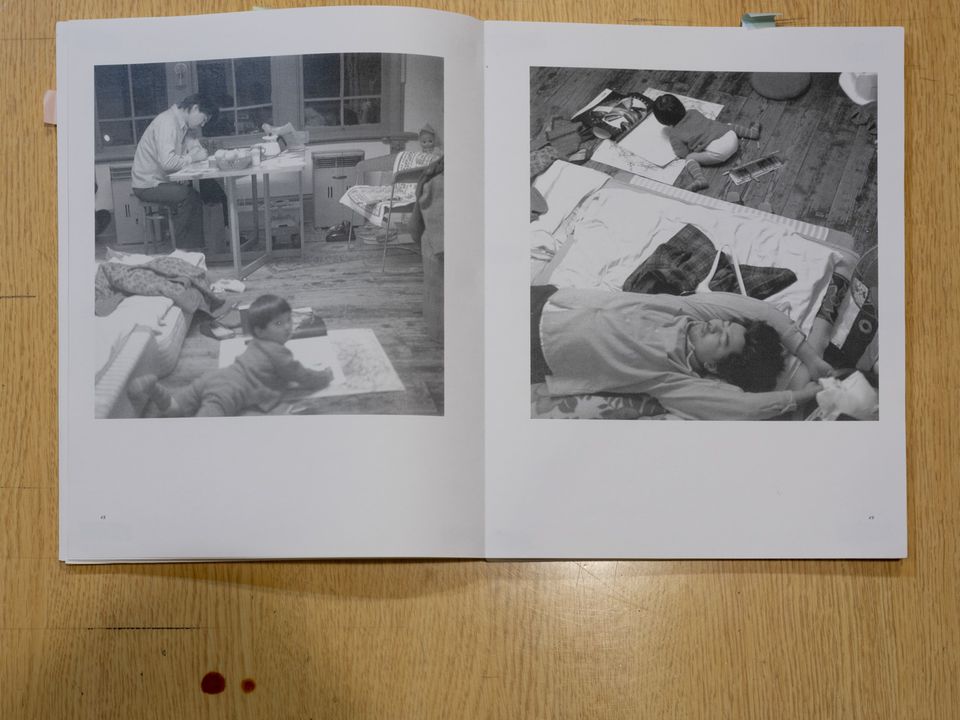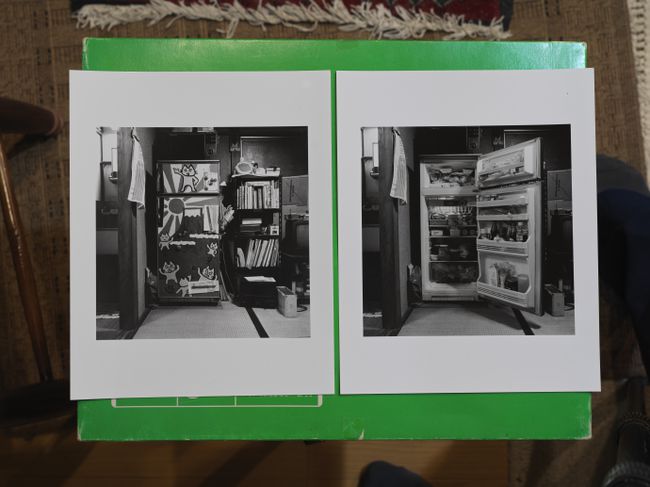Familiar Observations
Tokuko Ushioda in conversation with Stefano Graziani and Bas Princen
This oral history was filmed by Jonas Spriestersbach in December 2022 at Tokuko Ushioda’s home in Tokyo. It is part of the CCA project The Lives of Documents—Photography as Project, an open reflection on how past and contemporary image-making practices serve as critical tools to read our built environment and design today’s world.





- BP
- Do you still photograph people?
- TU
- I stopped photographing people for some time now. The better I got at photographing people, the more I started to doubt myself. It made me feel as if I was using the camera as a weapon against my subjects. Gradually, I began to feel the limits of this approach to photographing others. That’s when I transitioned to photographing refrigerators, which became the book ICE BOX.
I also took photographs of my family but never thought of publishing them. Those photographs were given a new life in the book My Husband, published by torch press in 2022. I never thought to publish those, until I came across some prints and negatives after having forgotten about them for forty years. I probably never thought of publishing that work earlier because my husband is also a photographer and he had a very successful book, Maho-chan, that portrays our life together with our daughter Maho. It didn’t occur to me to do anything that already seemed so familiar because of my husband’s photographs. But in the end, I was convinced that my photographs ultimately presented as My Husband were different from my husband’s photographs, even though we both were taking pictures in the same place at the same time of the life we made together in our tiny one-room rental.
My Husband
Life Of The Project
2022
Exhibition: My Husband
Organized at PGI, Tokyo, Japan
26 January – 12 March 2022
2022
Publication: My Husband
Published by torch press, Tokyo, Japan
2022
Exhibition: From Student to Master: Tokuko Ushioda and her Teachers
Organized at Alison Bradley Projects, New York, USA
17 May – 29 July 2022
2023
Exhibition: Lifelong Learning
Retrospective by the Yokohama Civic Art Gallery, Azamino, Yokohama, Japan
28 January – 26 February 2023
- SG
- Can you tell us more about the beginning of the ICE BOX project?
- TU
- One day my husband bought a huge used refrigerator that he had found for sale in an American military base. I wondered why three people needed such a big thing. But I thought okay, even if it was half-broken, it’s usable. For two or three years we used it and it was so strong that our vegetables froze immediately. The motor made a lot of noise, especially when I was sleeping. When I looked at the refrigerator, it made me wonder what kind of life I was leading. We slept right beside it and the loud sound it made above my head at night made me sit awake wondering what would happen to me in the future.
I never imagined myself living like that but so it was, and I started photographing my day-to-day living. The dominating presence of the refrigerator in that small room somehow represented all the things that seemed peculiar yet original about my life at that moment. I began to photograph others’ refrigerators after with my own. First, I photographed my landlord’s, my parents’, and then my friends’ refrigerators—the project spread and spread. I would at times meet some degree of hesitation; some people said they found it embarrassing to have their refrigerator photographed because they thought everyone would look inside. Maybe it’s a Japanese tendency, but I think some people felt as if they were publicly revealing their stomachs.
ICE BOX
Life Of The Project
1987
Exhibition: ICE BOX
Organized at Tokyo Design Centre, Tokyo, Japan
1992
Exhibition: ICE BOX
Organized at Gallery Sakura-gumi, Tokyo, Japan
1995
Exhibition: Photography City TOKYO
Group show organized at Tokyo Photographic Art Museum, Tokyo, Japan
1996
Publication: ICE BOX
Published by BeeBooks, Tokyo, Japan
1998
Exhibition: ICE BOX
Organized at Mitsubishi Estate Altium, Fukuoka, Japan
1999
Exhibition: ICE BOX
Organized at Lifestyle Design Centre, Setagaya, Tokyo, Japan
9 March – 28 March 1999
2008
Exhibition: ICE BOX
Organized at Port Gallery T, Osaka, Japan
13 October – 1 November 2008
2022
Exhibition: From Student to Master: Tokuko Ushioda and Her Teachers
Organized at Alison Bradley Projects, New York, USA
17 May – 29 July 2022
2023
Exhibition: Lifelong Learning
Retrospective at the Yokohama Civic Art Gallery Azamino, Yokohama, Japan
28 January – 26 February 2023
- BP
- Did you make your rules for composing pictures of refrigerators or did you follow a more casual approach?
- TU
- I wanted to accumulate shots of refrigerators like I was collecting specimens of insects. So, instead of shooting the refrigerator from various angles, I framed the entire thing. After, I developed a few rules for the project, such as shooting the same refrigerator with open and closed doors from the front. I wanted to represent everyday life in its truest settings. I played around with turning on lights or shooting with natural light, depending on what suited the situation. I framed both the refrigerator along with its surroundings using a 6 × 6 inch Zenza Bronica S2 camera, which is a square format camera. I didn’t want to tidy up or manipulate the space around the refrigerator. Even if something extra like a slipper or some household clutter happened to be sitting around, I left it in place to capture on the life of the house. Sometimes people organized or cleaned the inside of the refrigerator in advance, but other times people forgot—I thought that was good.
My refrigerator project is like opening a window into different lifestyles. The images feature few humans, but I think they reveal a lot about humanity. You can glean something about the person who uses the refrigerator and, over time as a series, you can learn something about the society they inhabit. I think I continued the project for fifteen years because I found it so interesting. Even now, I would keep working on it if I happened upon the appropriate opportunity and situation.

